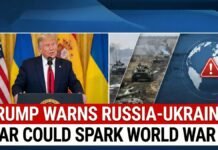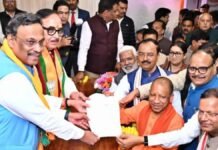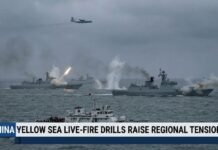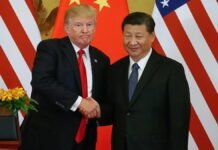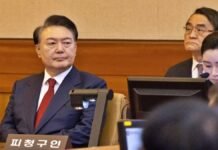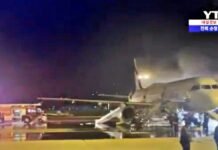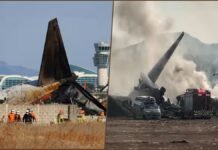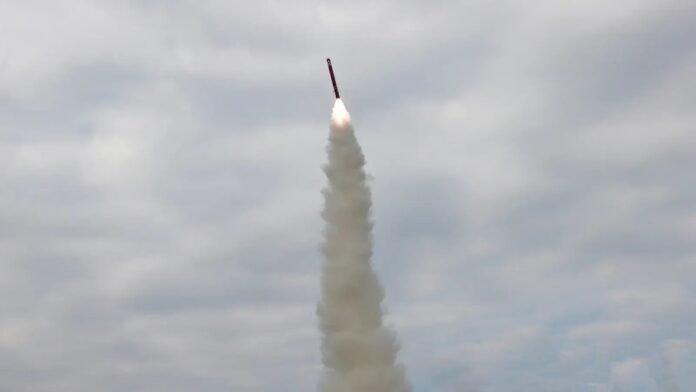
Key Points
- North Korea test-fired sea-to-surface strategic cruise missiles in the Yellow Sea on Tuesday, October 28, 2025, at approximately 3:00 PM local time
- The missiles flew for over 7,800 seconds (more than 2 hours) along a predetermined trajectory before accurately hitting targets
- Launch occurred just hours before US President Trump arrived in South Korea for APEC summit in Gyeongju
- Kim Jong Un did not personally oversee the test; Vice Chairman Pak Jong Chon supervised the launch instead
- Missiles believed to be Hwasal-type cruise missiles with estimated 1,500 km range, capable of reaching Japan and China
- North Korea has remained completely silent on Trump’s repeated offers to meet Kim Jong Un
- Analysts interpret the missile test as North Korea’s likely rejection of Trump’s “tenacious meeting offers”
- This marks North Korea’s second missile test within a week, following hypersonic ballistic missile tests on October 22
- Trump downplayed the test, stating Kim has been “firing missiles for decades” and expressing willingness to meet
- South Korea’s JCS detected launch preparations in advance; Seoul and Washington maintain combined defense readiness
New Delhi: North Korea conducted a provocative strategic cruise missile test on Tuesday, October 28, 2025, launching multiple sea-to-surface missiles from the Yellow Sea in what experts interpret as a calculated message timed to coincide with US President Donald Trump’s visit to South Korea. The Korean Central News Agency (KCNA) reported on Wednesday morning that the missiles, which had been improved for ship-based vertical launches, flew for more than 7,800 seconds, approximately 2 hours and 10 minutes, along a pre-set route before accurately striking their designated targets.
South Korea’s Joint Chiefs of Staff confirmed that they detected the missile launch preparations and the actual firing occurred around 3:00 PM local time (06:00 GMT) on Tuesday in North Korea’s northwestern waters. The South Korean military emphasized that it had identified these activities in advance and that Seoul and Washington are currently analyzing the missiles while maintaining a joint defense posture capable of delivering a “decisive response” to any provocations from the North.
The timing of the test was unmistakably deliberate, occurring just hours before President Trump touched down in Gyeongju, South Korea, on Wednesday morning to attend the Asia-Pacific Economic Cooperation (APEC) forum alongside other world leaders and business executives. Trump’s visit includes scheduled meetings with South Korean President Lee Jae-myung and Chinese President Xi Jinping as part of a broader Asian tour.
Significantly, North Korean leader Kim Jong Un did not personally attend or oversee the missile test, according to KCNA’s report. Instead, Pak Jong Chon, vice chairman of the Central Military Commission of the ruling Workers’ Party of Korea, supervised the launch and delivered statements about its strategic significance.
Technical Details and Strategic Capabilities
The missiles tested on Tuesday are believed to be one of the Hwasal-type cruise missiles that were publicly disclosed during North Korea’s annual defense exhibition held in Pyongyang earlier in October 2025. These strategic cruise missiles have been specifically improved for ship-based launches, representing an advancement in North Korea’s sea-based deterrent capabilities.
According to Hong Min, a senior analyst at the Korea Institute for National Unification, the missiles’ flight time of over 7,800 seconds suggests they could traverse approximately 1,500 kilometers, putting both Japan and China within operational range if fired from the Yellow Sea. This extended range significantly expands North Korea’s strike capabilities and demonstrates the regime’s technological progress in cruise missile development.
The missiles were launched vertically from sea platforms and flew along a predetermined trajectory over the Yellow Sea, showcasing North Korea’s ability to conduct coordinated naval-based missile operations. KCNA described these as “strategic cruise missiles,” a designation that analysts consistently interpret as a euphemism for missiles capable of carrying nuclear warheads.
Unlike ballistic missiles, which follow a high-arcing trajectory and are easier to detect and intercept, cruise missiles fly at lower altitudes and can maneuver during flight, making them more challenging for missile defense systems to counter. This characteristic enhances their strategic value as a deterrent and strike capability.
North Korea’s Message: Rejecting Trump’s Overtures
The most significant aspect of Tuesday’s missile test may be what North Korea did not say rather than what it demonstrated militarily. Throughout Trump’s Asian tour and in the days leading up to his South Korea visit, the US President has repeatedly extended public offers to meet with Kim Jong Un, which would mark the first encounter between the two leaders in more than six years.
During his flights between Asian capitals, Trump has expressed openness to negotiations, called North Korea a “sort of nuclear power,” suggested the possibility of negotiating sanctions relief, and even indicated he could extend his trip if a meeting with Kim could be arranged. These overtures represent a continuation of Trump’s previous diplomatic approach during his first term, when the two leaders met three times but failed to reach a substantive agreement on denuclearization.
However, as of Wednesday morning, North Korea’s state media had remained completely silent on Trump’s meeting offers. No official response, no acknowledgment, no diplomatic signals, only the cruise missile test conducted precisely as Trump was traveling to the region.
Lim Eul-chul, a professor at Kyungnam University’s Institute for Far Eastern Studies, interpreted Tuesday’s missile launch as a clear signal that “reaffirms Kim’s rejection of Trump’s tenacious meeting offers”. From this analytical perspective, the missile test serves as North Korea’s wordless answer to Trump’s diplomatic overtures: Pyongyang is not interested in repeating the pattern of summitry without substantive concessions from Washington.
Notably, state media targeting the domestic North Korean audience, such as the Rodong Sinmun newspaper, did not report on the latest missile launch. This omission suggests the test was primarily intended as a message to external audiences, particularly the United State,s rather than for domestic propaganda purposes.
Military Officials Emphasize Nuclear Deterrent
The statements accompanying the missile test emphasized North Korea’s determination to continuously strengthen its nuclear capabilities as a deterrent against what it perceives as threats from the United States and its allies. Pak Jong Chon, who supervised the launch, stated that “significant achievements” are being made in enhancing North Korea’s “nuclear forces” as a war deterrent.
“It is an extension of exercising the war deterrent and an act of exercising it more responsibly to continuously test the reliability of different strategic offensive means and impress their abilities upon the enemies,” Pak stated, according to KCNA. He further emphasized that “It is our duty and responsibility to continuously strengthen the nuclear combat readiness”.
These statements reflect North Korea’s longstanding position that its nuclear weapons program and missile development efforts are defensive measures necessitated by hostile US policies and military threats. By describing the tests as demonstrating capabilities “to adversaries,” North Korean officials signal that these weapons systems are not merely theoretical but operationally ready and intended to deter potential aggression.
Pak Jong Chon also called for the need to “steadily update North Korea’s combat capability,” indicating that missile testing will continue as part of an ongoing program to enhance military readiness. KCNA reported that the successful test would “contribute to expanding the operational sphere of the country’s nuclear-armed military”, suggesting integration of these cruise missiles into North Korea’s broader strategic forces.
Trump’s Measured Response
Despite the provocative timing and strategic implications of the missile test, President Trump adopted a notably measured and dismissive tone when addressing the launch. Speaking to reporters aboard Air Force One while flying from Japan to South Korea, Trump downplayed the significance of the test, stating that Kim Jong Un “has been firing missiles for decades”.
Trump also reaffirmed his willingness to engage diplomatically with the North Korean leader, expressing that he remains open to meeting with Kim despite the missile test. This response reflects Trump’s consistent approach of separating North Korea’s military activities from his personal relationship with Kim, which he has previously characterized in positive terms.
The President’s calm reaction contrasts with the more alarmed responses typically issued by military and security officials, who view each North Korean missile test as evidence of advancing capabilities and growing threats. Trump’s approach appears designed to keep diplomatic channels conceptually open while not appearing overly concerned about what he frames as routine North Korean behavior.
However, South Korean officials have clarified that there are no official plans for a meeting between Trump and Kim Jong Un during the current visit. This statement suggests that despite Trump’s public expressions of willingness, no back-channel communications have produced concrete arrangements for a summit.
Second Missile Test Within a Week
Tuesday’s cruise missile test represents North Korea’s second missile launch within a week, following an earlier test of what Pyongyang described as hypersonic missiles. Last Wednesday, October 22, 2025, North Korea launched what it termed two hypersonic missiles from Pyongyang, targeting a location on a plateau in the northeastern region.
The South Korean military classified those earlier launches as short-range ballistic missiles, though North Korea claimed they incorporated new hypersonic technology. Hypersonic weapons travel at speeds exceeding Mach 5 (five times the speed of sound) and can maneuver during flight, making them extremely difficult to intercept with current missile defense systems.
This pattern of frequent testing indicates North Korea’s continued advancement of its military power and technological capabilities across multiple weapon systems. The combination of ballistic missiles with hypersonic capabilities and long-range cruise missiles with potential nuclear payloads demonstrates a comprehensive approach to developing diverse strike options.
According to regional experts, this intensified testing schedule is part of a strategy to pressure the United States and South Korea while demonstrating capabilities to potential adversaries, including Japan. The tests also serve domestic political purposes, reinforcing the regime’s narrative that it is successfully defending the nation against external threats.
APEC Summit and Regional Diplomacy
The missile test occurred against the backdrop of the Asia-Pacific Economic Cooperation (APEC) forum being held in Gyeongju, South Korea, bringing together heads of state and business leaders from across the region. Trump’s schedule during his October 29-30 visit includes several significant bilateral meetings that will shape regional security discussions.
The centerpiece of Trump’s South Korea visit is his meeting with President Lee Jae-myung in Gyeongju, where the two leaders are expected to discuss alliance issues, North Korea policy, trade relations, and broader regional security concerns. The meeting provides an opportunity for the US and South Korea to coordinate their approach to North Korea’s recent provocations.
Equally significant is Trump’s scheduled meeting with Chinese President Xi Jinping during the APEC forum. China plays a crucial role in regional security dynamics as North Korea’s primary economic partner and diplomatic protector, and Trump’s discussions with Xi may touch on Beijing’s willingness to apply pressure on Pyongyang.
The White House confirmed these bilateral meetings as part of Trump’s broader Asian tour, which also included stops in Japan before South Korea. The presence of multiple world leaders at the APEC summit provided North Korea with a high-profile target for its messaging through the missile test.
Experts had warned before the APEC summit that North Korea could launch provocative missile tests before or during the event to demonstrate its capabilities and protest the gathering of US allies in the region. Tuesday’s launch confirmed these predictions, though the relatively measured international response suggests that such tests have become somewhat normalized in regional security dynamics.
Recent North Korean Diplomacy and Military Developments
The cruise missile test occurs within a broader context of North Korea’s evolving international relationships and military posture. Recent diplomatic developments include Russian President Vladimir Putin engaging with a leading North Korean diplomat, with Putin stating that the Russia-North Korea relationship is “progressing as intended”.
This deepening relationship between Pyongyang and Moscow has raised concerns among Western analysts, particularly regarding potential technology transfers and military cooperation. Reports have suggested that North Korea may be providing ammunition and military supplies to Russia for use in Ukraine, while Russia may be offering advanced military technology or economic assistance in return.
These developments occur as North Korea continues to reject nuclear talks with Washington, maintaining that it will not return to negotiations unless the United States fundamentally changes its “hostile policy” toward the regime. This position represents a significant shift from the dialogue-oriented approach during Trump’s first term, when Kim and Trump held three summit meetings despite failing to reach a comprehensive agreement.
The failure of previous Trump-Kim summits to produce lasting agreements has left both sides skeptical about the value of renewed diplomacy without substantial changes in negotiating positions. North Korea has consistently demanded sanctions relief before taking denuclearization steps, while the United States has insisted on verifiable denuclearization before lifting sanctions—a fundamental impasse that previous meetings failed to resolve.
Historical Context of Trump-Kim Diplomacy
The current situation must be understood within the historical context of Trump and Kim’s previous diplomatic engagement during Trump’s first term. The two leaders held three highly publicized summit meetings: in Singapore (June 2018), Hanoi (February 2019), and at the Korean Demilitarized Zone (June 2019).
These meetings represented an unprecedented level of engagement between a sitting US President and North Korean leader, breaking decades of diplomatic ice. Trump’s willingness to meet Kim face-to-face without preconditions represented a departure from traditional US policy.
However, the summits ultimately failed to produce a lasting agreement on North Korea’s nuclear weapons program or the lifting of international sanctions. The Hanoi summit in particular ended abruptly without an agreement, with both sides walking away from negotiations after failing to bridge fundamental differences on the scope of denuclearization and the extent of sanctions relief.
In the six years since the last Trump-Kim meeting, North Korea has continued developing its nuclear weapons program and missile capabilities without significant international constraints. This track record makes both Trump and Kim skeptical about the value of renewed summitry without substantial changes in negotiating positions.
The current missile test, interpreted by analysts as rejecting Trump’s meeting offers, suggests that Kim may be unwilling to repeat the pattern of high-profile summits that produce media attention but no substantive results. From Pyongyang’s perspective, agreeing to meet Trump again without secured concessions in advance would weaken its negotiating position.
Ongoing Testing Pattern and Future Outlook
North Korea’s cruise missile test represents part of a sustained pattern of weapons testing that has continued throughout 2025 despite international condemnation and sanctions. The regime shows no signs of slowing its military development programs, regularly conducting tests of various missile systems to advance technical capabilities and operational readiness.
Experts anticipate that North Korea will continue testing activities in the coming weeks and months, particularly as it seeks to demonstrate progress in specific weapons programs. Future tests may include additional cruise missile launches, ballistic missile tests with various ranges and capabilities, and potentially even nuclear-related activities if Pyongyang seeks to escalate tensions further.










